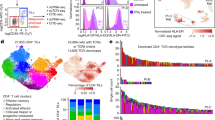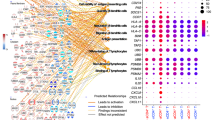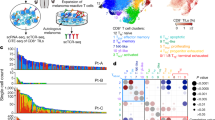Abstract
CD4+ T cells modulate the magnitude and durability of CTL responses in vivo, and may serve as effector cells in the tumour microenvironment. In order to identify the tumour epitopes recognized by tumour-reactive human CD4+ T cells, we combined the use of an HLA-DR4/peptide binding algorithm with an IFN-γ ELISPOT assay. Two known and three novel CD4+ T cell epitopes derived from the gp 100/pmel17 and tyrosinase melanocyte-associated antigens were confirmed or identified. Of major interest, we determined that freshly-isolated PBMC frequencies of Th1-type CD4+ T recognizing these peptides are frequently elevated in HLA-DR4+ melanoma patients (but not normal donors) that are currently disease-free as a result of therapeutic intervention. Epitope-specific CD4+ T cells from normal DR4+ donors could be induced, however, after in vitro stimulation with autologous dendritic cell pulsed with antigens (peptides or antigen-positive melanoma lysates) or infected with recombinant vaccinia virus encoding the relevant antigen. Peptide-reactive CD4+ T cells also recognized HLA-DR4+ melanoma cell lines that constitutively express the relevant antigen. Based on these data, these epitopes may serve as potent vaccine components to promote clinically-relevant Th1-type CD4+ T cell effector function in situ. © 2001 Cancer Research Campaign http://www.bjcancer.com
Similar content being viewed by others
Article PDF
Change history
16 November 2011
This paper was modified 12 months after initial publication to switch to Creative Commons licence terms, as noted at publication
References
Albert ML, Sauter B and Bhardwaj N (1998) Dendritic cells acquire antigen from apoptotic cells and induce class I-restricted CTLs. Nature 392: 86–89
Aruga A, Aruga E, Cameron MJ and Chang AE (1997) Different cytokine profiles released by CD4+ and CD8+ tumor-draining lymph node cells involved in mediating tumor regression. J Leuk Biol 61: 507–516
Barger BO, Acton RT, Soong SJ, Roseman J and Balch C (1982) Increase of HLA-DR4 in melanoma patients from Alabama. Cancer Res 42: 4276–4279
Bour H, Horvath C, Lurquin C, Cerottini JC and MacDonald HR (1998) Differential requirement for CD4 help in the development of an antigen-specific CD8+ T cell response depending on the route of immunization. J Immunol 160: 5522–5529
Brinckerhoff LH, Thompson LW and Slingluff CL Jr (2000) Melanoma vaccines. Curr Opin Oncol 12: 163–173
Cochlovius B, Stassar M, Christ O, Raddrizzani L, Hammer J, Mytilineos I and Zoller M (2000) In vitro and in vivo induction of a Th cell response toward peptides of the melanoma-associated glycoprotein 100 protein selected by the TEPITOPE program. J Immunol 165: 4731–4741
Czarnecki D, Nicholson I, Tait B and Nash C (1993) HLA DR4 is associated with the development of multiple basal cell carcinomas and malignant melanoma. Dermatol 187: 16–18
Falk K, Rotzschke O, Stevanovic S, Jung G and Rammensee HG (1994) Pool sequencing of natural HLA-DR, DQ, and DP ligands reveals detailed peptide motifs, constraints of processing, and general rules. Immunogenetics 39: 230–242
Gjertson DW and Lee SH (1998) HLA 1998. Gjertson DW Terasaki PI 450 Lenexa, KS, Am. Soc. Histocompatibility and Immunogenetics
Grohmann U, Fioretti MC, Bianchi R, Belladonna ML, Ayroldi E, Surace D, Silla S and Puccetti P (1998) Dendritic cells, interleukin 12, and CD4+ T lymphocytes in the initiation of class I-restricted reactivity to tumor/self peptide. Crit Rev Immunol 18: 87–98
Halliday GM, Patel A, Hunt MJ, Tefany FJ and Barnetson RS (1995) Spontaneous regression of human melanoma/nonmelanoma skin cancer: association with infiltrating CD4+ T cells. World J Surg 19: 352–358
Herr W, Protzer U, Lohse AW, Gerken G, Meyer zum Buschenfelde KH and Wolfel T (1998) Quantification of CD8+ T lymphocytes responsive to human immunodeficiency virus (HIV) peptide antigens in HIV-infected patients and seronegative persons at high risk for recent HIV exposure. J Inf Dis 178: 260–265
Honeyman MC, Brusic V, Stone NL and Harrison LC (1998) Neural network-based prediction of candidate T-cell epitopes. Nature Biotechnol 16: 966–969
Kast WM, Brandt RM and Melief CJ (1993) Strict peptide length is not required for the induction of cytotoxic T lymphocyte-mediated antiviral protection by peptide vaccination. Eur J Immunol 23: 1189–1192
Kawakami Y, Robbins PF, Wang RF, Parkhurst M, Kang X and Rosenberg SA (1998) The use of melanosomal proteins in the immunotherapy of melanoma. J Immunother 21: 237–246
Kittlesen DJ, Thompson LW, Gulden PH, Skipper JC, Colella TA, Shabanowitz J, Hunt DF, Engelhard VH, Slingluff CL Jr and Shabanowitz JA (1998) Human melanoma patients recognize an HLA-A1-restricted CTL epitope from tyrosinase containing two cysteine residues: implications for tumor vaccine development. J Immunol 160: 2099–2106
Lorenz HM, Hieronymus T, Grunke M, Manger B and Kalden JR (1997) Differential role for IL-2 and IL-15 in the inhibition of apoptosis in short-term activated human lymphocytes. Scand J Immunol 45: 660–669
Lotze MT, Hellerstedt B, Stolinski L, Tueting T, Wilson C, Kinzler D, Vu H, Rubin JT, Storkus WJ, Tahara H, Elder E and Whiteside T (1997) The role of interleukin-2, interleukin-12, and dendritic cells in cancer therapy. Cancer J Sci Am 3S: 109–114
Matloubian M, Concepcion RJ and Ahmed R (1994) CD4+ T cells are required to sustain CD8+ T-cell responses during chronic viral infection. J Virol 68: 8056–8063
Ogoshi K, Tajima T, Mitomi T and Tsuji K (1994) HLA-DR4 antigen and lymph node metastases in poorly differentiated adenocarcinoma of the stomach. Cancer 73: 2250–2252
Ossendorp F, Mengede E, Camps M, Filius R and Melief CJ (1998) Specific T helper cell requirement for optimal induction of cytotoxic T lymphocytes against major histocompatibility complex class II negative tumors. J Exp Med 187: 693–702
Ranieri E, Kierstead LS, Zarour H, Kirkwood JM, Lotze MT, Whiteside T and Storkus WJ (2000) Dendritic cell/peptide cancer vaccines: clinical responsiveness and epitope spreading. Immunol Inv 29: 121–125
Sgadari C, Angiolillo AL, Cherney BW, Pike SE, Farber JM, Koniaris LG, Vanguri P, Burd PR, Sheikh N, Gupta G, Teruya-Feldstein J and Tosato G (1996) Interferon-inducible protein-10 identified as a mediator of tumor necrosis in vivo. Proc Natl Acad Sci USA 93: 13791–13796
Skipper JC, Hendrickson RC, Gulden PH, Brichard V, Van Pel A, Chen Y, Shabinowitz J, Wolfel T, Slingluff CL Jr., Boon T, Hunt DF and Engelhard VH (1996) An HLA-A2-restricted tyrosinase antigen on melanoma cells results from posttranslational modification and suggests a novel pathway for processing of membrane proteins. J Exp Med 183: 527–534
Southwood S, Sidney J, Kondo A, del Guercio MF, Appella E, Hoffman S, Kubo RT, Chesnut RW, Grey HM and Sette A (1998) Several common HLA-DR types share largely overlapping peptide binding repertoires. J Immunol 160: 3363–3373
Storkus WJ and Zarour HM (2000) Melanoma antigens recognised by CD8+ and CD4+ T cells. Forum (Genova) 10: 256–270
Tannebaum CS, Tubbs R, Armstrong D, Finke JH, Bukowski RM and Hamilton TA (1998) The CXC chemokines IP-10 and Mig are necessary for IL-12-mediated regression of the mouse RENCA tumor. J Immunol 161: 927–932
Topalian SL, Gonzales MI, Parkhurst M, Li YF, Southwood S, Sette A, Rosenberg SA and Robbins PF (1996) Melanoma-specific CD4+ T cells recognize nonmuted HLA-DR-restricted tyrosinase epitopes. J Exp Med 183: 1965–1971
Touloukian CE, Leitner WW, Topalian SL, Li YF, Robbins PF, Rosenberg SA and Restifo NP (2000) Identification of a MHC class II-restricted human gp 100 epitope using DR4-IE transgenic mice. J Immunol 164: 3535–3542
Tueting T, Wilson CC, Martin DM, Kazamon Y, Rowles J, Ma DI, Slingluff CL Jr, Wagner SN, van der Bruggen P, Baar J, Lotze MT and Storkus WJ (1998) Autologous human monocyte-derived dendritic cells genetically modified to express melanoma antigens elicit primary cytotoxic T cell responses in vitro: Enhancement by cotransfection of genes encoding the Th1-biasing cytokines IL-12 and IFN-α. J Immunol 160: 1139–1147
Tuvy DN and Blum JS (1998) Detection of biotinylated cell surface receptors and MHC molecules in a capture ELISA: a rapid assay to measure endocytosis. J Immunol Meth 212: 9–18
Vidard L, Rock KL and Benacerraf B (1992) Heterogeneity in antigen processing by different types of antigen-presenting cells. Effect of cell culture on antigen processing ability. J Immunol 149: 1905–1911
Author information
Authors and Affiliations
Rights and permissions
From twelve months after its original publication, this work is licensed under the Creative Commons Attribution-NonCommercial-Share Alike 3.0 Unported License. To view a copy of this license, visit http://creativecommons.org/licenses/by-nc-sa/3.0/
About this article
Cite this article
Kierstead, L., Ranieri, E., Olson, W. et al. gp100/pmel17 and tyrosinase encode multiple epitopes recognized by Th1-type CD4+T cells. Br J Cancer 85, 1738–1745 (2001). https://doi.org/10.1054/bjoc.2001.2160
Received:
Revised:
Accepted:
Published:
Issue date:
DOI: https://doi.org/10.1054/bjoc.2001.2160
Keywords
This article is cited by
-
A listing of human tumor antigens recognized by T cells: March 2004 update
Cancer Immunology, Immunotherapy (2005)
-
Locoregional immunotherapy of malignant effusion from colorectal cancer using the streptococcal preparation OK-432 plus Interleukin-2
British Journal of Cancer (2003)



